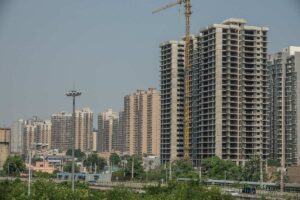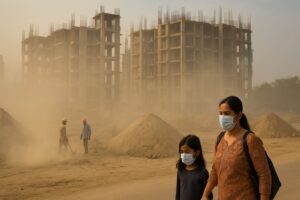
You leave on time. But you never reach on time. The road looks still, but it is not. It is jammed. From Char Murti Chowk to Shahberi Goal Chakkar, the same scene plays out every morning. Cars locked bumper to bumper. Rickshaws cutting in. Horns everywhere. And no real space to move.
It is not just traffic. It is daily pressure on broken systems. At Ek Murti Chowk, near Galaxy Vega, and past the Hanuman Mandir Gol Chakkar, people are stuck in loops. Every signal feels like a stop without reason. Greater Noida’s roads are choked, not by accident—but by patterns that repeat every single day.
Main Problem Zones Making Life Difficult
Every road does not carry the same pain. In Greater Noida, some spots are now known for daily blocks and loud frustration. These are not random areas. They are choke points where design, delay, and neglect all meet.
Char Murti Chowk to Shahberi Goal Chakkar
This stretch feels like a trap. Four roads meet here, but no proper light or lane rule works. Cars from Gaur City, Amrapali, and Shahberi pile into one circle. Auto-rickshaws block exits. School vans rush in from wrong sides. And people keep waiting. You can sit here for 25 minutes without moving even 5 feet.
GNIDA promised a proper U-turn and underpass. But on ground, there is still confusion and patchwork fixes.
Ek Murti Chowk to Galaxy Vega
This was meant to be smooth. But Galaxy Vega’s road is now a narrow lane with sharp turns. Buses stop mid-lane. Builder trucks enter without warning. Pedestrians cross anywhere. And the new U-turn near Ek Murti? It started, yes. But full relief is still far.
Around 9:00 AM, it takes 20–30 minutes just to cross Ek Murti to Char Murti signal. The pressure starts early and stays till 11.
Surajpur Road and Hanuman Mandir Gol Chakkar
This circle is holy, but chaotic. Traffic from Dadri, Ecotech, and Delta converge here. Trucks line the side. The temple zone has no divider, and turns are blind. On school days, the jam touches Golden-I.
There is no signal light at the Hanuman Mandir Gol Chakkar. And still, people expect vehicles to move smoothly.
Golden-I U-Turn (Commercial Traffic Woes)
This U-turn is not wide. But hundreds of cars and vans try to flip there every hour. Shops open on both sides. Delivery bikes rush in. No traffic cop, no boards, no guides. Just a free-for-all chaos near a major real estate site.
Root Causes Nobody Is Talking About
These jams are not random. They happen for reasons that stay hidden from headlines. Noida Extension’s daily traffic pain is not just about more cars. It is about missing systems, broken plans, and ignored basics.
Service Roads Exist but Are Not Enough
Greater Noida West does have service roads. But they are not built for this kind of pressure. Societies like Galaxy Vega, SKA GreenArch, and Fusion Homes have thousands of flats. At least 70 percent of families own a car or two-wheeler. The volume is too high. These roads were never planned for such dense traffic coming out all at once.
Take Fusion Homes as an example. Vehicles from both sides enter and exit without break. There is no lane guide. No buffer space. Just a long queue of school vans, autos, cab drivers, and delivery trucks—all pushing through the same narrow lane. Even without traffic lights, the road stays blocked. Because it is not about signals. It is about space that just does not hold.
Signals Do Not Match Real Traffic Flow
Greater Noida West has no red lights, but that does not mean traffic flows smoothly. At most crossings and U-turns, there is no proper lane break or flow guide. All types of vehicles—cars, school vans, bikes—arrive together. There is no timing gap. Everyone moves at once, and the road locks.
The problem is clear at Ek Murti Chowk. Vehicles turn from both sides, while others try to cross straight. School vans take wide loops. Bikes cut from side gaps. Pedestrians are stuck between vehicles. Even the new U-turn work by GNIDA has not eased the block during peak hours. There is no pause between lanes. Just one tight point of constant conflict.
Builder Traffic Adds Silent Pressure
Heavy vehicles from construction sites are a big reason for road blocks in Greater Noida West. These dumper trucks, concrete mixers, and material loaders move at slow speed and take wide turns. They enter during office hours and mix into the same road used by cars, bikes, and school vans.
There is no separate time slot for them. No fixed entry route. Most builder trucks stop mid-lane near project gates. This breaks the traffic line and creates a ripple block. At sites like Gaur Aspire Leisure Park, and nearby towers, builder movement is regular. But traffic control is missing.
Footpaths Used for Parking or Shops
Footpaths in many parts of Greater Noida West are not used for walking. They are blocked by street vendors, food carts, and parked bikes. In places like Ek Murti Chowk, Galaxy Vega Gol Chakkar, and near the Hanuman Mandir Gol Chakkar, pedestrians are forced to walk on the road itself.
This pushes people into traffic lanes. Cars slow down to avoid them. Two-wheelers weave around. Movement breaks. Even on wide roads, this side friction builds up. And every small pause adds to the main jam.
What Residents Are Seeing Every Day
Traffic in Greater Noida West is not just a timing issue. It is a pattern created by vehicles that should not be there during peak hours. Most jams happen at the same fixed points, around the same time, every day.
Construction Trucks Keep Moving During Office Hours
Big projects are still going on in most sectors. But the real problem is that builder trucks, dampers, and concrete mixers keep running all day. They are supposed to stop during office hours. But nobody checks.
These trucks take wide turns, stop mid-lane, and block small service roads. They move slowly but take big space. One damper reversing can stop an entire stretch for ten minutes. This is not rare. This is happening daily.
Gol Chakkars Are Entry-Exit Chaos Points
Each Gol Chakkar (like Galaxy Vega Gol Chakkar, Hanuman Mandir Gol Chakkar) connects at least 7 to 8 roads. That means traffic is coming in and going out at the same time—from all directions. There are cars, bikes, autos, and even trucks—all trying to push first.
No one slows down. No one waits. Everyone wants to cross first. There is no signal, no circle control, and no divider guide. It becomes a full block from every side, especially when a truck or bus tries to turn in the middle.
What GNIDA and Police Have Promised So Far
GNIDA and the local police have announced several initiatives to address traffic congestion in Greater Noida West. However, many of these plans are still in progress, and residents continue to face daily traffic challenges.
- U-Turn Construction: A new U-turn is being constructed near the Ek Murti Roundabout to alleviate traffic congestion between Galaxy Vega and Ek Murti Chowk.
- Underpass Development: GNIDA plans to develop a six-lane underpass on the Taj Highway, connecting Greater Noida to Gaur City and the Delhi-Meerut Expressway.
- Road Widening: The Shahberi-Crossings Republik Road has been widened by 3 meters to ease traffic congestion in the Shahberi market area.
- Traffic Restrictions: Noida Police have imposed restrictions on the entry of heavy vehicles during peak hours on key stretches, including the Noida-Greater Noida Expressway.
Who Should Take Real Responsibility
The traffic problem in Greater Noida West is not caused by just one issue. It is the result of high vehicle pressure, non-stop construction, and poor real-time management. The roads are active all day. But the control is missing.
Builders continue moving dumper trucks and concrete mixers during office hours. This breaks the traffic flow. Even after Noida Police issued notices about restricted timings for heavy vehicles, many trucks still enter peak zones.
At Galaxy Vega Gol Chakkar, large construction vehicles enter directly onto the service road between 8 and 10 AM. Near Sector 10 and Sector 13, cement mixers often stop mid-lane while reversing. GNIDA guidelines clearly say that builder traffic should avoid peak time movement
In Char Murti, Ek Murti, and Shahberi, police teams are seen—but even with presence, the junction design creates chaos. These roundabouts connect 7 to 8 roads, and there is no fixed flow. Cars, autos, trucks, and bikes all try to push first.
The pressure is growing. And until each one acts where they should, the problem will stay right outside your gate.
How Locals Can Help Reduce Daily Traffic Load
Most people think traffic is someone else’s problem. But in Greater Noida West, even small changes by residents can help break daily jam loops. It starts with the road you live on—and the timing you follow.
Stand Inside the Gate for Pickup
Do not wait on the main road or just outside the gate for your cab, auto, or school van. It blocks the entry lane. Even two bikes or one car standing near the gate slows everything. Just step inside the society gate and call the driver. This clears up the exit path.
Avoid Wrong-Side Shortcuts Near Intersections
Many two-wheelers take wrong-side entries at U-turns or chowks to save 2 minutes. But these shortcuts break traffic rhythm and confuse drivers from other sides. This often causes full block within 5 minutes. Use the correct side. It keeps things moving for everyone.
Do Not Park on Service Lane Corners
Some drivers leave their vehicle near corner turns of service roads, especially near shops or waiting zones. These spots are already narrow. Parking even partly on the road causes complete jam when a delivery truck comes. Always park after the turn, not before it.

 Greater Noida
Greater Noida

